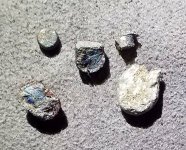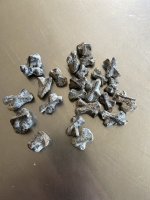Boarteats
Full Member
I have a love/hate relationship with my gold source material. I'm struggling to find a good flux mixture. Lots of experimentation. I'm making progress, which is good news.
Anyway, thought that I'd share one of the oddest smelting results that I've had. I decided to try a variant of the flux that I've used for smelting iron from magnetite, a neutral ph flux in a low O2 env.
Results are in attached pic. Top left and lower right are silver/gold and no iron. The pieces on the diagonal were originally one button that I broke apart. These are mostly iron with what appears to be copper or copper/gold on outside margin and something BLUE in the center. I think that the blue might be a copper oxide or something. Not sure, but it looks really cool!

Anyway, thought that I'd share one of the oddest smelting results that I've had. I decided to try a variant of the flux that I've used for smelting iron from magnetite, a neutral ph flux in a low O2 env.
Results are in attached pic. Top left and lower right are silver/gold and no iron. The pieces on the diagonal were originally one button that I broke apart. These are mostly iron with what appears to be copper or copper/gold on outside margin and something BLUE in the center. I think that the blue might be a copper oxide or something. Not sure, but it looks really cool!

Upvote
0





